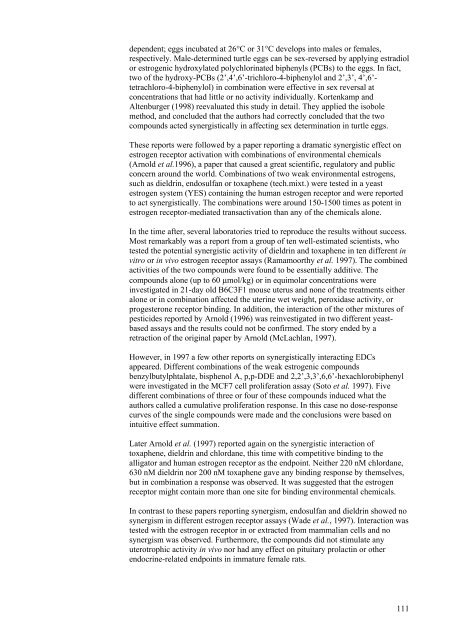Combined Actions and Interactions of Chemicals in Mixtures
Combined Actions and Interactions of Chemicals in Mixtures
Combined Actions and Interactions of Chemicals in Mixtures
You also want an ePaper? Increase the reach of your titles
YUMPU automatically turns print PDFs into web optimized ePapers that Google loves.
dependent; eggs <strong>in</strong>cubated at 26°C or 31°C develops <strong>in</strong>to males or females,<br />
respectively. Male-determ<strong>in</strong>ed turtle eggs can be sex-reversed by apply<strong>in</strong>g estradiol<br />
or estrogenic hydroxylated polychlor<strong>in</strong>ated biphenyls (PCBs) to the eggs. In fact,<br />
two <strong>of</strong> the hydroxy-PCBs (2’,4’,6’-trichloro-4-biphenylol <strong>and</strong> 2’,3’, 4’,6’tetrachloro-4-biphenylol)<br />
<strong>in</strong> comb<strong>in</strong>ation were effective <strong>in</strong> sex reversal at<br />
concentrations that had little or no activity <strong>in</strong>dividually. Kortenkamp <strong>and</strong><br />
Altenburger (1998) reevaluated this study <strong>in</strong> detail. They applied the isobole<br />
method, <strong>and</strong> concluded that the authors had correctly concluded that the two<br />
compounds acted synergistically <strong>in</strong> affect<strong>in</strong>g sex determ<strong>in</strong>ation <strong>in</strong> turtle eggs.<br />
These reports were followed by a paper report<strong>in</strong>g a dramatic synergistic effect on<br />
estrogen receptor activation with comb<strong>in</strong>ations <strong>of</strong> environmental chemicals<br />
(Arnold et al.1996), a paper that caused a great scientific, regulatory <strong>and</strong> public<br />
concern around the world. Comb<strong>in</strong>ations <strong>of</strong> two weak environmental estrogens,<br />
such as dieldr<strong>in</strong>, endosulfan or toxaphene (tech.mixt.) were tested <strong>in</strong> a yeast<br />
estrogen system (YES) conta<strong>in</strong><strong>in</strong>g the human estrogen receptor <strong>and</strong> were reported<br />
to act synergistically. The comb<strong>in</strong>ations were around 150-1500 times as potent <strong>in</strong><br />
estrogen receptor-mediated transactivation than any <strong>of</strong> the chemicals alone.<br />
In the time after, several laboratories tried to reproduce the results without success.<br />
Most remarkably was a report from a group <strong>of</strong> ten well-estimated scientists, who<br />
tested the potential synergistic activity <strong>of</strong> dieldr<strong>in</strong> <strong>and</strong> toxaphene <strong>in</strong> ten different <strong>in</strong><br />
vitro or <strong>in</strong> vivo estrogen receptor assays (Ramamoorthy et al. 1997). The comb<strong>in</strong>ed<br />
activities <strong>of</strong> the two compounds were found to be essentially additive. The<br />
compounds alone (up to 60 µmol/kg) or <strong>in</strong> equimolar concentrations were<br />
<strong>in</strong>vestigated <strong>in</strong> 21-day old B6C3F1 mouse uterus <strong>and</strong> none <strong>of</strong> the treatments either<br />
alone or <strong>in</strong> comb<strong>in</strong>ation affected the uter<strong>in</strong>e wet weight, peroxidase activity, or<br />
progesterone receptor b<strong>in</strong>d<strong>in</strong>g. In addition, the <strong>in</strong>teraction <strong>of</strong> the other mixtures <strong>of</strong><br />
pesticides reported by Arnold (1996) was re<strong>in</strong>vestigated <strong>in</strong> two different yeastbased<br />
assays <strong>and</strong> the results could not be confirmed. The story ended by a<br />
retraction <strong>of</strong> the orig<strong>in</strong>al paper by Arnold (McLachlan, 1997).<br />
However, <strong>in</strong> 1997 a few other reports on synergistically <strong>in</strong>teract<strong>in</strong>g EDCs<br />
appeared. Different comb<strong>in</strong>ations <strong>of</strong> the weak estrogenic compounds<br />
benzylbutylphtalate, bisphenol A, p,p-DDE <strong>and</strong> 2,2’,3,3’,6,6’-hexachlorobiphenyl<br />
were <strong>in</strong>vestigated <strong>in</strong> the MCF7 cell proliferation assay (Soto et al. 1997). Five<br />
different comb<strong>in</strong>ations <strong>of</strong> three or four <strong>of</strong> these compounds <strong>in</strong>duced what the<br />
authors called a cumulative proliferation response. In this case no dose-response<br />
curves <strong>of</strong> the s<strong>in</strong>gle compounds were made <strong>and</strong> the conclusions were based on<br />
<strong>in</strong>tuitive effect summation.<br />
Later Arnold et al. (1997) reported aga<strong>in</strong> on the synergistic <strong>in</strong>teraction <strong>of</strong><br />
toxaphene, dieldr<strong>in</strong> <strong>and</strong> chlordane, this time with competitive b<strong>in</strong>d<strong>in</strong>g to the<br />
alligator <strong>and</strong> human estrogen receptor as the endpo<strong>in</strong>t. Neither 220 nM chlordane,<br />
630 nM dieldr<strong>in</strong> nor 200 nM toxaphene gave any b<strong>in</strong>d<strong>in</strong>g response by themselves,<br />
but <strong>in</strong> comb<strong>in</strong>ation a response was observed. It was suggested that the estrogen<br />
receptor might conta<strong>in</strong> more than one site for b<strong>in</strong>d<strong>in</strong>g environmental chemicals.<br />
In contrast to these papers report<strong>in</strong>g synergism, endosulfan <strong>and</strong> dieldr<strong>in</strong> showed no<br />
synergism <strong>in</strong> different estrogen receptor assays (Wade et al., 1997). Interaction was<br />
tested with the estrogen receptor <strong>in</strong> or extracted from mammalian cells <strong>and</strong> no<br />
synergism was observed. Furthermore, the compounds did not stimulate any<br />
uterotrophic activity <strong>in</strong> vivo nor had any effect on pituitary prolact<strong>in</strong> or other<br />
endocr<strong>in</strong>e-related endpo<strong>in</strong>ts <strong>in</strong> immature female rats.<br />
111

















